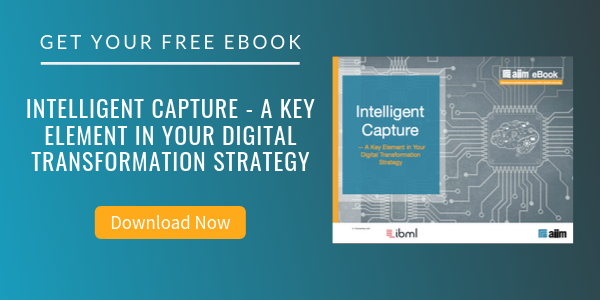
17 Things You Should Know about Scanning and Capture
According to our in-house analyst, Doug Miles, "Offices are at last using less paper. Although still growing in 27% of organizations, in 39%, paper usage is finally starting to fall. However, the strongest drivers for scanning and capture are not savings on paper storage space but improved searchability and knowledge sharing, followed by productivity improvements in document-centric business processes. Nearly 40% of the organizations surveyed reported investment payback within 12 months of implementing systems. We also compare strategies for outsourcing, centralized scanning, and distributed scanning, and look at levels of capture integration with other enterprise systems."
Here's a snapshot of some of the key findings from AIIM's latest research report, "Capture and Business Process: The Drivers and Experiences of Content-Driven Processes."
-
The strongest driver for scanning and capture is improved searchability and knowledge sharing across the business, followed by productivity improvements, reduced office costs, and better customer service.
-
66% of responding organizations have a formal scan-to archive process, and 47% utilize some form of workflow, but only 16% scan and extract data to a process. When scanning to archive, only half use automatic recognition of metadata for indexing.
-
39% of responding organizations reach positive payback on their investments in scanning, capture, and BPM within 12 months, rising to 60% within 18 months. Automatic document classification shows a particularly high return for the 19% of respondents utilizing it.
-
Improved process productivity and process quality produce significant financial savings, but respondents were as likely to cite better knowledge sharing and access as providing a significant financial return.
-
The consumption of paper and the number of photocopies is still growing in 27% of responding organizations, but in 39%, it is finally starting to fall. Among those organizations with more extensive and mature scanning and capture operations, 53% are seeing a reduction in paper usage.
-
61% of respondents are processing scanned images, 30% are processing electronic Office files and emails, and 26% are processing faxes for data capture prior to process.
-
Only 14% of organizations are using capture and BPM across multiple processes and departments.
-
Regarding forward strategies for scanning and capture, outsourcing is showing a very small net gain, whereas respondents are posting very positive preferences for both centralized and distributed capture in-house, and are making big moves towards automated data recognition and document auto-classification.
-
These strategies are reflected in a projected net rise in spend on capture and BPM software modules, compared to a more neutral projection for scanner hardware and for outsourcing.
-
55% of larger organizations, 32% of mid-sized organizations, and 22% of smaller organizations use outsourcing.
-
Only a third of these are doing any form of data capture for process (44% of larger orgs) and only 20% are outsourcing any part of the process itself.
-
The primary driver for outsourcing is to cut costs, with the next factor identified as the need to focus staff on core tasks. 88% are satisfied with the quality of service provided by their outsourcer.
-
The most popular enterprise systems to be capture-enabled are Finance, Line of Business, and HR, followed by Service, Claims, and Case Processing. Generally, only half of these systems are enabled and integrated at a process level.
-
58% of SharePoint users are not storing scanned image files, and only 9% are executing any workflow or BPM with scanned images. File sizes and the ability to handle scanned image throughput are the biggest concerns.
-
60% of respondents have one or more capture and BPM systems. Of these, 39% have a single system in use for all applications. Of those with multiple systems, 80% are looking to converge to a single system.
-
Although respondents expressed a preference to source workflow and BPM as part of an ECM suite or as part of SharePoint, the decision-maker for capture and BPM is likely to be a department or Line of Business head, compared to a Head of IT or Head of Compliance for the ECM system.
-
Resistance to change and a lack of awareness of the possibilities of BPM were indicated as the most commonly encountered management issues arising in a capture and BPM project. Difficulties of integration with other systems, and time taken to map processes, were the biggest technical issues.
About John Mancini
John Mancini is the President of Content Results, LLC and the Past President of AIIM. He is a well-known author, speaker, and advisor on information management, digital transformation and intelligent automation. John is a frequent keynote speaker and author of more than 30 eBooks on a variety of topics. He can be found on Twitter, LinkedIn and Facebook as jmancini77. Recent keynote topics include: The Stairway to Digital Transformation Navigating Disruptive Waters — 4 Things You Need to Know to Build Your Digital Transformation Strategy Getting Ahead of the Digital Transformation Curve Viewing Information Management Through a New Lens Digital Disruption: 6 Strategies to Avoid Being “Blockbustered” Specialties: Keynote speaker and writer on AI, RPA, intelligent Information Management, Intelligent Automation and Digital Transformation. Consensus-building with Boards to create strategic focus, action, and accountability. Extensive public speaking and public relations work Conversant and experienced in major technology issues and trends. Expert on inbound and content marketing, particularly in an association environment and on the Hubspot platform. John is a Phi Beta Kappa graduate of the College of William and Mary, and holds an M.A. in Public Policy from the Woodrow Wilson School at Princeton University.



